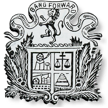The town continued to grow. More mills were opened and engineering works were set up. The population increased rapidly. By 1851 it had reached 5,872 and by 1871, 7,538.
The rapid growth of the town and the process of industrialisation seemed to leave the local people with little time to plan their town or attend to the wellbeing of its inhabitants. Housing was of a poor standard and outbreaks of disease were common. By the middle of the nineteenth century, the situation had become serious. It was clear that something had to be done. One way forward was to form a burgh and a meeting was called in the Assembly Rooms behind the Black Bull Inn. The Burgh Police Act was adopted in 1857. A section of the population, however, was opposed to these moves. Many of the good people, careful of their pennies, thought that a little lawlessness was a small price to pay to be free of the burden of paying rates. Passions ran high.
After a bitterly contested election in 1861, a riot broke out. Members of the Council had to flee and the council chamber and police quarters were wrecked. The mob moved on to attack the homes and business premises of various commissioners, as councillors were called then. A great bonfire was lit in the evening in Houston Square. The town’s meagre police force was powerless to control the mob and the magistrates summoned the troops from the Paisley barracks. A detachment of the 76th Regiment arrived during the night. When the good people awoke the next morning, they found the town partly devastated but in the firm hands of the military.
The town council, once established, began to make improvements in the living conditions of the people. 1869 saw the introduction of a public water supply and in the 1870s Johnstone began to enjoy the benefits of a public sewage system.
One of the areas in which Johnstone had been somewhat lax was in the provision of schooling for its children. Schools had grown up in a somewhat haphazard manner and were of variable quality. In 1865, there were only two schools which received any money from public funds. These were the Quarrelton Side School and the Johnstone Ragged School. The Quarrelton Side School was the larger of the two. It occupied what had formerly been a house on the edge of the mining village of Quarrelton.
It is difficult to imagine what conditions inside the building were like. 280 pupils were on the roll and a typical attendance was 230. All these were in the charge of one male teacher, assisted by three pupil teachers. Discipline must have been strict and, even granted a particularly able and energetic teacher, it is difficult to see how standards could have been high. However, the school does seem to have been a successful one. Reports by her Majesty’s Inspector of Schools were favourable and the school attracted a government grant of £63.10s. This in itself is evidence that the school was efficient. The curriculum included Latin and French and several pupils went on to universities.
Another school, Johnstone Ragged School was held in brick built single storey building in Ludovic Square, “erected in accordance with government plans.” It had two classrooms which housed 131 pupils. Instruction was in the hands of one male teacher.
Besides these two schools, which might by the standards of the time, be regarded as satisfactory, there were several other schools. A Roman Catholic school met in the upper storey of an old cotton mill and there were two schools, run on private commercial lines, in Quarry Street and Church Street. The Government Inspectors would approve neither of these, as conditions were cramped and the staff not qualified in any way. However, they seem to have been popular with parents. Even once the new public school opened, it is possible these private ventures lingered on. In 1887 a school run by a Mrs Beaton was in existence. Presumably when state education became free in 1890, it soon closed.
A final feature of the variegated provision of education in the 1860’s was the part-time schools of which there were two, one in the Temperance Hall and one at the Cartside Mill. These were provided as a philanthropic gesture by the mill owners and enabled children, aged 10 and upwards, to attend school in the morning and work in the afternoon or vice versa.
It is difficult to know how effective such a system, if it can be dignified with that name, was in providing for the educational needs of the area. In Scotland, about 79% of children aged 5-13 were receiving education in 1871. One forms the impression that the situation in Johnstone was certainly no better than the national average. Illiteracy must have been widespread. In1859 in Scotland 11% of men and 21% of women used a cross rather than a signature on their marriage documents. The fact that the figures for England are worse, (28% and 38%) may allow one to feel a certain partisan pride but the situation in Scotland was certainly not one any thinking person could be happy about.
The dissatisfaction of the community with the situation was voiced by the ministers. The United Presbyterian minister wrote that “there is no schoolroom (in the burgh of Johnstone) that is even decent, and no teacher of any standing, except the Ragged School and its master.” The minister of the High Church explained that efforts had been made from time to time to improve the situation but these had been frustrated by sectarian differences between the members of the different Protestant denominations. It was clear that something had to be done. In the late 1860s a Free Mission School was set up, catering for 135 pupils.
However, 1872 saw the enacting of the Education (Scotland) Act, which had far reaching results. School Boards were set up in each parish and were instructed to provide elementary education for all children in the parish. Attendance was compulsory for children between 5 and 13 with certain exceptions. Funds were to be provided from three sources: a local rate of about 2d in the £ was levied, children were to be charged fees of 2d or3d per week and the Government would make grants to school boards if the inspectors decided that the schools were run on acceptable lines.
The New Public School opens.
Johnstone fell within the landward division of Paisley Abbey Parish and a school board was quickly elected. After considering the situation, they decided in 1874 that the best plan was to provide a completely new building, rather than adapt and enlarge any of the existing buildings. Messrs Pilkington and Bell of Edinburgh were engaged as architects and contractors selected. The Board, who obviously knew what they liked in matters of architecture, decided to add as a final flourish, a stone tower, although they may have been influenced by the fact that it was available at a bargain price of £280. As was common, a school house was provided at a cost of £500.
The building in Floors Street proceeded according to plan although, as seems to be almost inevitable in these matters, the cost which had been estimated at between £3,000 and £4,000 gradually rose to the dizzy sum of £9,255 9s 1d. A heating system which had been overlooked when the school was planned was hurriedly installed during the first winter and the Board, keeping their doubts as to the cost to themselves, congratulated each other on the contribution they had made to the dignity of the town.
The building first opened on June 11th,1877. All went well. The headmaster, Matthew Wilson MA, was pleased with his brand-new school and his pupils. In the school log book, he noted that the scholars “are very careful of the new furniture and are conducting themselves admirably.” The official opening took place some time later, on Tuesday, 22nd August, a particularly wet day and some 250 of the older pupils listened to speeches by local dignitaries, expressing the town’s pride in its new acquisition and looking “for success, for results, for the government inspector placing the school at the very top of the list.”
The Government inspector was an important man. During the years 1877-1886, he paid annual visits to the school. The date was arranged in advance and when the fateful arrived each pupil was tested and the school in general reviewed. The inspector then submitted his report to the Scotch Education Department. As the grant the Board received depended on the average attendance and how many pupils had passed the test required of the different age groups, the inspector’s visit was a momentous event and his report, a copy of which was sent to the school.
Although they were not slow to point out what they saw as shortcomings, in general, inspectors’ reports on Johnstone Public School were favourable and, in particular, complimentary of the headmaster, Mr Matthew Wilson. The report for 1886, the last year in which an individual examination of the pupils was carried out, can be taken as typical of the period 1877-1886. The inspector speaks of the “great ability” of Mr Wilson and remarks “that a thoroughly healthy tone pervades all the departments.” He praises “the large upper division of the First Standard is in an excellent condition, Reading specially deserving mention. He notes that “there is great sprightliness in singing.”
One of the effects of these regular examinations by Her Majesty’s Inspectors was that a tight control was kept by the Scotch Education Department over what was taught. The first three primary years, or standards as they were called, were principally concerned with basics of Reading, Writing and Arithmetic, what were usually known, rather oddly, as the 3 Rs. Along with these were included Physical Education and Class Singing. By Standard IV, some pupils were judged able to profit from the study of two from a list of Specific Subjects. Those offered in 1886 in Johnstone Public School included Mathematics, English Literature, Latin, Animal Physiology, Physical Geography, Botany and Domestic Economy. An impressive list, indeed!
Mr Wilson seemed keen to enlarge the list of Specific Subjects available. In 1895, he asked the School Board to employ teachers of French and Cookery, these subjects “not hitherto having been taught in Johnstone Public School.” Mr A C Robertson and Miss A B Crichton were subsequently employed. In 1902, he returned with a request for teachers qualified to teach German and Music, but the Board felt that things were quite satisfactory as they were and decided to take no action. Eventually German was included in the curriculum.
At this distance in time, it is difficult to recapture what the conditions were under which teaching took place. Classes were large, in some cases at least. A government report of 1865 had claimed that “a good master is quite able to interest and teach eighty or a hundred boys in the earlier years of their course.” It seems unlikely that classes in Johnstone ever reached these numbers. A more probable figure is seventy. Classrooms were large to accommodate such a number.
In the junior classes, pupils practised writing and arithmetic on slates. The School Board informed its teachers in 1881 that. At the beginning of each session, or when a scholar enters the school, a slate to be supplied to each scholar-numbered-
and if it break or if he loses the slate, the scholar to replace
the slate by one of the same kind.
There were those who argued against the slate. Boys tended to clean it by spitting onto it and giving it a wipe with their sleeve, obviously an unhygienic process, and if the slate was dropped, it could produce a nasty gash on an unshod foot. Economy, however, prevailed at least until the twentieth century.
The teaching force which coped with these conditions, one cannot help feeling, must have been heroic. Most entered the profession by a kind of apprenticeship system. They began work as a pupil teacher at the age of 17 or 18, being paid £20-£25 per annum. Besides performing their classroom duties, they were also taught by the teacher for 5 hours per week. Some teachers taking the senior classes were university graduates.
One thing that is immediately striking when looking at the early records of the school is the concern of all over attendance. Pupils were wont to take days off for a variety of reasons, to see a circus, to go to the Paisley Races, to prepare for the Dancing School Ball, all very much to the annoyance of Mr Wilson. However, there was a more serious undercurrent of absence about which there was concern. In January 1887, at a time when 125 pupils from a total roll of 1069 were absent, an investigation was held with the following results: -
Causes of Absence – 11 January,1887.
General Poverty – want of clothing etc 31
Scarlet Fever 16
Enteric Fever 5
General Sickness 58
Excluded for nonpayment of fees 4
Absent without cause 11
Total 125
Standards of general health in those days were, of course, much lower than today. Reluctantly the school was closed for a month from December 1882 – January 1883 because of an epidemic of Measles. On one occasion, Mr Budge, the Attendance Officer, was accused of overzealously forcing back to school pupils who had not fully recovered from an infection. People then were much poorer and children might not be adequately clad to come to school in cold weather.
In 1905, Mr James Coats offered to supply “all needful children” with a pair of boots, two pairs of stockings and a pair of garters. 1121 pupils laid claim to his charity, about 70% of the roll, although the School Board claimed “that the kindness of Mr Coats had been in many cases abused.” James Coats had run Coats mills in the USA before returning to Scotland. The artist is James Guthrie.
Although the Education Act laid down that all young people between 5 – 13 (increased to 14 in 1883) had to attend school, certain exceptions were allowed. Older pupils could attend school for half the day and work for the remainder. Pupils who had passed Standard V in the three Rs were excused altogether. In Johnstone in 1888, for example, 321 pupils were half timers as they were called, and 165 had total exemption and presumably did a full day’s work. This curious left over from the past was abolished in 1901.
This was written in 1976-7 at the time of the centenary of Johnstone High School. The general background is based on James Scotland: The History of Scottish Education and Charles A Scott : The History of Johnstone ( an impressive work.)
The account of the Quarrelton school draws on the report of the Government Argyll Commission (about 1865) which surveyed schools throughout Scotland. Even now, I can remember sitting in the Mitchell Library, working my way through it. The account of events after the Education (Scotland) Act 1872 is based initially on the minutes of the Paisley Abbey Parish School Board. The area of the School Board was the places around Paisley, but excluding Paisley itself. It included Cardonald, for example.
Once the school was in operation the headmaster was required to keep a logbook of what happened each day and the logbooks are the source of the accounts of the Johnstone Public School. I was able to read the minutes of the Board and the entries in the logbook. They were preserved in the Strathclyde Regional Archive. I think it was located in what is now the Museum of Modern Art. Who knows where it is now?
The painting, the Dominie, is in the collection of Paisley Art Institute. The portrait of James Coats is in Paisley Museum. They can be found on the Art UK website.
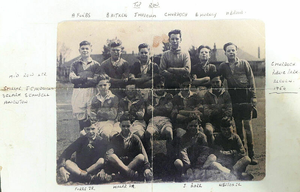
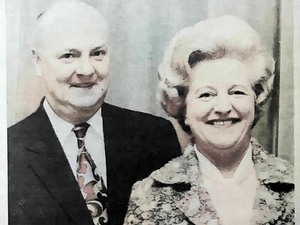
The following article was published by Eddie McRorie on 19th August 2023 on the Johnstone History Facebook page and is reproduced here with his kind permission.
David Crawford was a farmers son from Sproulston Farm in Howwood and attended school in Lochwinnoch. He spent his early years working on the farm until the family started the well known dairy business in Johnstone, Crawford’s Dairies.
Crawford Dairies
While David was growing up on the farm , a girl called Edith Napier was also
growing up on a farm in Perthshire where they met and fell in love at Gleneagles
being there through their interest in golf.
They started off their married life on a farm at Lochwinnoch with Edith
commenting that this was a time in their lives they greatly enjoyed.
Owning to pressure of work in the Crawford’s Dairy business the couple moved to
Johnstone to a house named Dunmore in Thomson Avenue (named after a former
Provost).
Later they moved to the mansion house known as Lynnhurst in Park Road,
Johnstone. (The house was built for ex-provost John Lang Jnr. of Lang Lathes.)
and it was there after being married for ten years that they were blessed with
two daughters Fiona and Catriona.
Edith Crawford’s many interests included curling and the W.R.V.S. She was a
founder member and ex chairman of Johnstone Evening Townswomen’s Guild.
David Crawford is also keen on curling and was a member of St Mirrin Curling
Club in Paisley.
He is also well remembered in Johnstone for his 15 years of service in Johnstone
Town Council. During this time he was convenor of the Housing Management
Committee, and Treasurer, a Bailie and Police Judge.
One of David’s earliest memories is in the 1930’s Major Harold Glen-Coats
decided to have milk from the Crawford Farm at Howwood delivered to his
Ferguslie House. He was a very particular gentleman and his milk was put in
locked containers with the only people having keys being the Crawford and the
Major himself.
He also called at the farm once a month to inspect the cows. When the Glen-Coats
family went to their shooting lodge at Ardrishaig they still had to have
Crawford’s milk which was taken to Gilmour Street Station in Paisley and put on
a train to Gourock. From there it went by the steamer St Columba to Ardrishaig.
In due course the family decided to sell out to Express Dairies which later
merged with Scottish Farmers and David Crawford remained as a director of the
group for a number of years.
Lynnhurst Hotel
During this time the active Edith Crawford
decided to turn Lynnhurst mansion house into a small private hotel. However the
business grew so quickly that David was forced to give up his other work and
manage the hotel.
The Lynnhurst hotel was a success and when Woodlands the mansion next door
became available the Crawfords took it over. The two houses were then joined by
a large extension which coasted of a function suite holding 200 and a new
cocktail bar.
The conjoined hotel now had 34 bedrooms, 14 en-suite and 4 with showers, and the
Crawford’s thoroughly enjoyed their life of dispensing hospitality to visitors,
many of whom come from far away parts of the world.
In spite of the work of running this busy hotel the couple were still involved
with activities around the district and their services were constantly sought by
various organisations.
David Crawford was a founder member and ex-chairman of Ayrshire Young
Farmers Club and together they enjoyed keeping in touch with grass roots farming
of their early lives.
The Lynnhurst Hotel has changed hands more than once since David and Edith
Crawford owned it and is today a well known and liked venue in demand for
weddings and every kind of function.
Edith and David Crawford have left a lasting contribution to the fabric of
Johnstone.
On a personal note my late mother Betty McRorie a founder member of the ladies
bowling section of the Municipal Bowling Greens and my late father a member of
the gents used to retire to the The Bird In Hand at Quarellton for a refreshment
after the wappenshaw found a The new Lynnhurst Hotel a welcome addition in Park
road across from the bowling club. The Crawfords were well known to my parents
and it was no surprise when my mother, never one to miss an opportunity, who was
looking for new a new sponsor and trophy for the Ladies mixed pairs competition
asked Edith about being the sponsor to which Edith readily agreed. My mother
left it to Edith Crawford to pick a trophy and as you can see from the
accompanying photo of the presentation of trophies Edith did not disappoint by
buying the biggest trophy the club had dwarfing all the others. My mother is far
left on back row.
Click the link below to view photographs related to the
Crawford family.
Clicking on individual photographs will display them full size.
Thanks to Mark Good for his work on the video, to Ryan Bradley for the audio, to Kukscinema Scotland for drone footage and to Iain Murray of Johnstone History Museum for his assistance.
Revised 6 February 2024.
Recommendation: Expand video to full screen.

This first story starts when John McFarlane, a visitor to the Museum, told us about his father's uncle, Tom McFarlane, who had worked in Loudon Bros Machine Tool Company in Johnstone. He added that Tom had not only worked in Loudon's but had been in charge of a small team who travelled to Russia to install a huge planing machine in a Russian Machine shop. John subsequently brought us in a photograph of this event. The Machine was a Planing Machine and one of the largest machine tools made by Loudons.
Revised 6 February 2024.
While searching the London Gazette I found the following entry in a Supplement dated 24 Feb. 1942, page 894 - The Military Cross awarded to Lieutenant (Temporary Captain) Thomas Stevenson Craig (85709), Royal Tank Regiment, Royal Armoured Corps (Johnstone, Renfrewshire).
This is another Angela Gillespie Story. Click the link below.
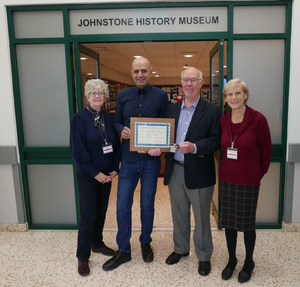
Johnstone History Museum, which is located within the Morrisons store in Johnstone achieved a huge milestone the other day when it welcomed its 50,000th visitor through the door.
Tassum Shafiq, from Bridge of Weir, was welcomed by two of the Museum volunteers, Helen Bowie and Marlene Rogan. At an event organised to celebrate the occasion, Tassum was presented with a traditional Scottish Quaich and a commemorative Certificate by the Chairman of the Johnstone History Society, Iain Murray.
Iain reported that he was delighted to see the Museum achieve such an important milestone and thanked the whole team of volunteers who keep the whole show running. The Community Museum opened its doors in April, 2008, the year after the Morrisons store itself opened. Visitors come in from all over the world but it is also great to welcome locals who discover a lot about their own town for the first time. The Museum also hosts school groups and local interest groups for organised visits by arrangement.
When asked how it all came about, Iain stated that, “when the Supermarket was being planned, discussions were held between the Council planning department, Morrisons’ Directors and members of Johnstone History Society, about the possibility of incorporating a purpose built Community Museum within the store. With financial help from the Heritage Lottery Fund the present facility came to pass.
“Johnstone History Society, owes a huge debt of thanks to the late Councillor John Kenny, the late Adam Lynch and his wife Janette who put in a huge amount of work to help create the Museum that we see in place today. The present team carry on the work they created”.
The Museum contains a huge amount of information, photographs, historic documents, maps, memorabilia and industrial artefacts that chart the history of the town from February, 1782, when George Houstoun, the Laird of Johnstone planned the Town, to the present day.
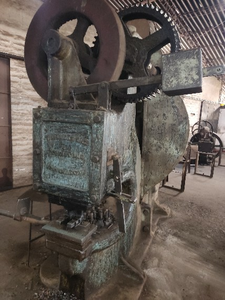
For more Thomas Shanks Machine Tools go to Thomas Shanks
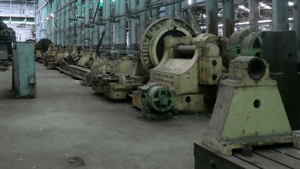
For more Thomas Shanks Machine Tools at Cockatoo click on link Thomas Shanks
The Cockatoo Island Dockyard was a major dockyard in Sydney, Australia, based on Cockatoo Island. The Dockyard was established in 1857to maintain Royal Navy warships. It later built and repaired military and battle ships, and played a key role in sustaining the Royal Australian Navy. The Dockyard was closed in 1991, and its remnants are heritage listed as the Cockatoo Island Industrial Conservation Area. Credit Wikipedia.
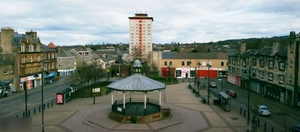
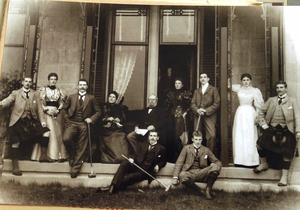

We were able to find information about the McLaurins who lived in the Mansion over the years. Cartside House was sited on the land across the road from the present Smith & McLairin Company Premises.
Follow the link below to read the story of the history of Cartside House.
Categories
Recent Posts
- The Origins of Johnstone High School. By Sandy Morton
- Public Park football team from 1954
- The Crawford Family
- Johnstone Band - Black Cart Water
- Johnstone Machine Tool from Loundons reached Russia
- Videos
- WW1 Roll of Honour List Update
- Captain Thomas Stevenson Craig M.C
- The Story of the Glasgow to Ardrossan Canal that only reached Johnstone
- Museum Reaches Major Milestone
- Johnstone Machine Tools reached Chile
- Johnstone Machine Tools used in Australia
- Great Drone video of Johnstone by Kukscinema Scotland
- Kali (MacLaurin) Lindner's hunt for her Roots
- Kali (MacLaurin) Lindner's hunt for her Roots
